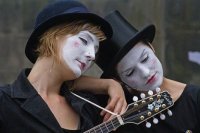Planning a Lesson, Telling a Story
Your content has been saved!
Go to My Saved Content.How many of you would go see a movie or read a book that was all mixed up? Let's face it, we all like a good beginning, middle and end in movies and books. So why not in our lessons?
If you think about a book or movie, the beginning should catch your attention. I don't know about you, but if the beginning doesn't catch my attention I will probably quit reading the book and might leave the movie. So how do we catch the attention of students? We call that a hook; something that makes students curious, something that makes them want to learn more. That is our beginning in a lesson.
Let's look at the Common Core Standards in writing as a foundation and source of possible beginnings.
Kindergarten Standard
CCSS.ELA-LITERACY.W.K.1: Use a combination of drawing, dictating, and writing to narrate a single event or several loosely linked events; tell about the events in the order in which they occurred; and provide a reaction to what happened.
Beginning: Be a mime for a few minutes. Explain to students that you are going to tell them a story without words. You want them to watch and, at the end, guess what the story was. Then use pictures and gestures to tell a story.
6th Grade Standard
CCSS.ELA-LITERACY.W.6: Write argSupport claims with clear reasons and relevant evidence, using credible sources and demonstrating an understanding of the topic or text.
Beginning: If you wrote that standard on the board and said, "This is what we're going to do today," the students would start ignoring you right away. Instead, think about starting class with a little controversy. Act as if you are reading a news article that states dogs with long hair are smarter than dogs with short hair, and give several made up claims about why this is true. Then discuss it. Middle school students love to debate, and that kind of claim will grab their attention. Make the reasons so strange that they start looking at you and wondering what's going on.
11th - 12th Grade Standard
CCSS.ELA-LITERACY.W.11-12.1.e: Provide a concluding statement or section that follows from and supports the argument presented.
Beginning: If you have an iPad, there is a Twilight Zone app. This app gives you the start of a story, then stops. Use something similar to that. Show an exciting video clip, have a storyteller visit your room and start a story. Then have students, in groups if you want, finish the story. Tell them any conclusion is acceptable as long as they can provide argument how the conclusion relates to the story.
The Rest of the Plan
Now that we have our beginnings, what about the middle? This does not mean the middle is boring. However, since we do have everyone's attention, the middle is full of information. Look at the standards we are using; what would be your middle? Post it in the comments section below, and let's talk.
And then there's . . . the ending! This is where you bring the lesson to a close. You might do that by repeating the beginning, you might give the conclusion yourself, or lead the students there and let them give the conclusion. When you create the ending, you are answering the question, "What do I want my students to remember?"
But wait -- you aren't finished! Students need time to reflect. Reflection on the entire lesson is as important as the beginning. I like to give students a sticky note or 3X5 card and have them write the most important thing they learned, and up to two questions that they still have. Then I ask them to write why they think this lesson is important. Careful here, let them be honest. It will assist you in planning future lessons.
So, try it. Tell us about your beginnings and reflections.
